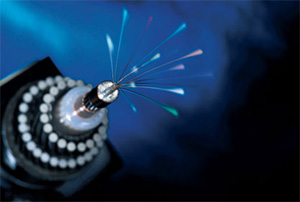

|
||
 This is a cross-section example of Tyco Telecommunications’ steel armored cable. This specific type of cable is installed on the ocean floor, usually in shallow water. Source: SEACOM
This is a cross-section example of Tyco Telecommunications’ steel armored cable. This specific type of cable is installed on the ocean floor, usually in shallow water. Source: SEACOM
The SEACOM submarine cable, completed in the past 24 hours, is the first modern submarine cable connecting to eastern Africa, and the first of an unprecedented wave of new cable projects on both the eastern and western coasts of Africa. Approximately USD2.4 billion in new submarine cable projects are scheduled for completion by the end of 2011.
The plans for so many new cables reflect both Africa’s lack of international communications infrastructure, and soaring capacity requirements. According to TeleGeography’s Global Bandwidth Research Service, international bandwidth demand in Sub-Saharan Africa grew 68% between 2007 and 2008. However, this region has been poorly connected to the web of global communications networks—until the launch of SEACOM, East African communications companies had to rely solely on expensive satellite links for international connectivity.
While SEACOM will be the first cable connected to eastern Africa, it will soon be joined by two further cables. The East African Marine System (TEAMS), scheduled for completion later in 2009, will link Kenya and the United Arab Emirates, and the Eastern African Submarine Cable System (EASSy), which lands in many of the same countries as SEACOM, is expected to commence service in mid-2010.
The western coast of Africa, which is currently served only by the SAT-3 cable, is experiencing a similar investment boom: four new cable projects are currently planned. The long-awaited Glo-1 cable is expected to link Nigeria and Ghana to Europe later this year. The privately-funded Main One cable will link Nigeria and Ghana to Portugal in May 2010, and the USD600 million West Africa Cable System (WACS) consortium cable is due to be completed in 2011. Finally, France Telecom is leading the Africa Coast to Europe (ACE) project, which will link 25 countries in Europe and West Africa by 2011.
‘These new cables will not only bring much needed international capacity to eastern and western Africa, but will also introduce competition into the international communications market in Africa. This will greatly reduce costs to African service providers and consumers, and enable the development of new services,’ said TeleGeography Research Director Alan Mauldin.
Sponsored byVerisign

Sponsored byWhoisXML API

Sponsored byRadix

Sponsored byDNIB.com

Sponsored byIPv4.Global

Sponsored byCSC

Sponsored byVerisign
